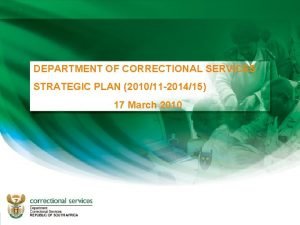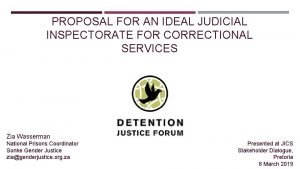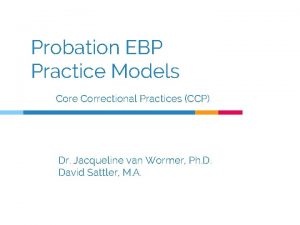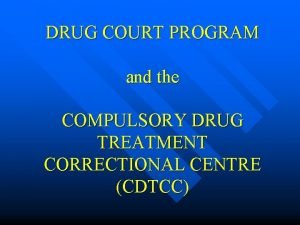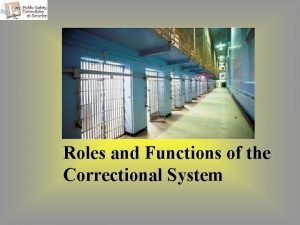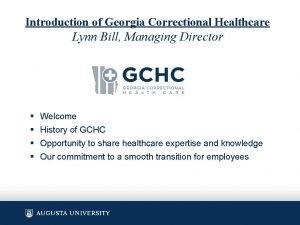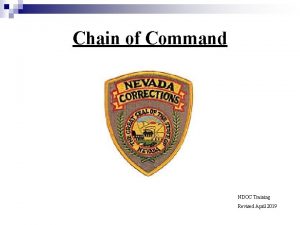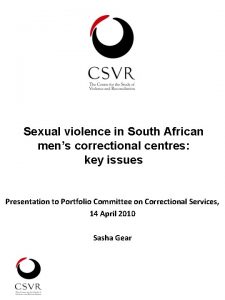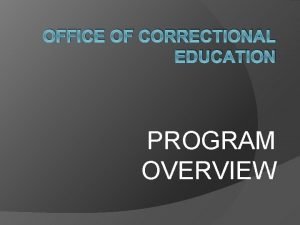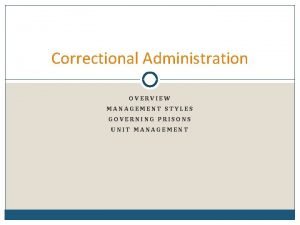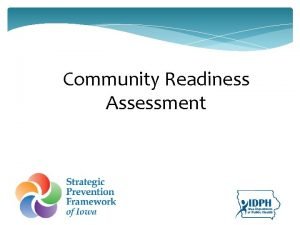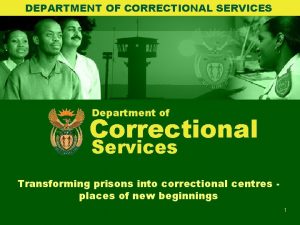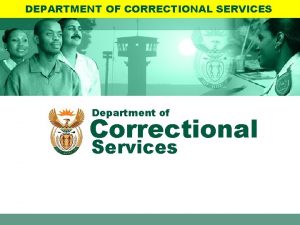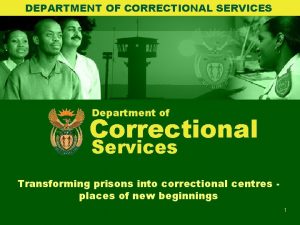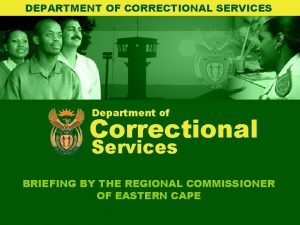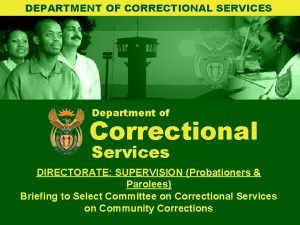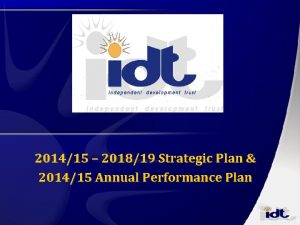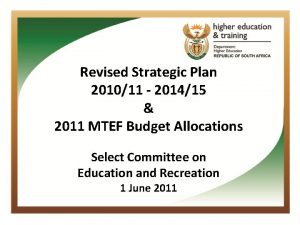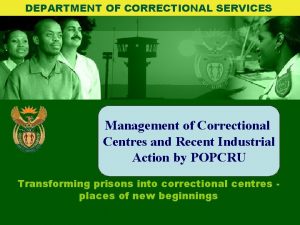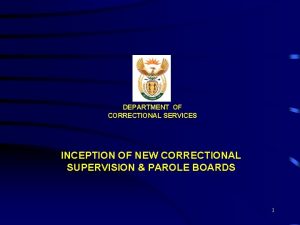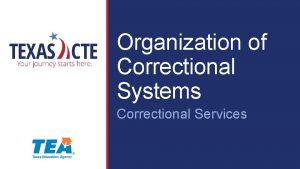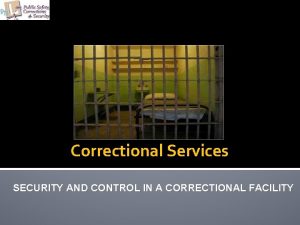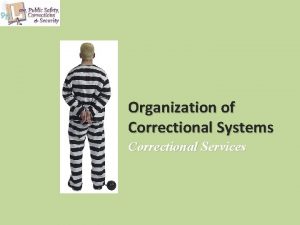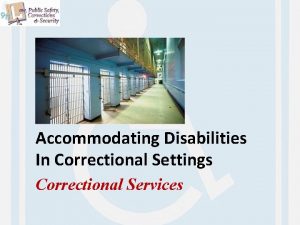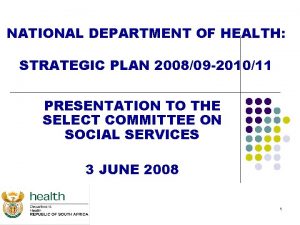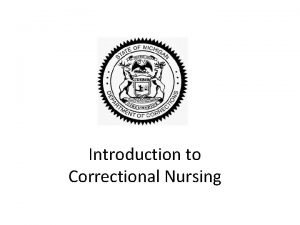DEPARTMENT OF CORRECTIONAL SERVICES STRATEGIC PLAN 201011 201415

























- Slides: 25

DEPARTMENT OF CORRECTIONAL SERVICES STRATEGIC PLAN (2010/11 -2014/15) 17 March 2010

CONTENTS • • Introduction Structure of Strategic Plan Priority Areas Section D – – – Programme purpose, measurable objectives Programme Performance Project Portfolio Management Strategy Service Delivery Improvement Plan Strategic Human Resource Management • Conclusion 2

INTRODUCTION § Current strategic plan developed against backdrop of financial constraints § During review department outlined criteria or requirements for each strategy § Strategies in plan are ones that were funded, met HR requirements (recruitment and development) and other necessary inputs such as Technology strategy § Strategies that do not fulfil requirements were shifted to outer years when requirements can be fulfilled 3

§ Document outlines priorities – MTSF priorities are linked with specific strategies in Programme Performance and cross references – Departmental priorities are also presented in Programme Performance and Portfolio Management Strategy § Departmental Service Delivery Improvement Plan is over three year period § Summary of HR Plan as required in terms of Part IIID of Public Service Regulations is included in Strategic Plan 4

STRUCTURE OF STRATEGIC PLAN • Structure of Strategic Plan in accordance with Public Service Regulations Part III (B 1) – Part A • Forewords by Ministry and introduction by Acting National Commissioner – Part B • Strategic overview • Legislative framework • Policies, priorities and strategic goals – Part C • Expenditure trends • Multi-year projects of income • Information systems – Part D • Programme Performance • Project Portfolio Management Strategy • Service Delivery Improvement Plan • Strategic Human Resource Management 5

PRIORITIES • Plan reflects 11 priority areas that must be delivered on in Medium Term Expenditure Framework (MTEF) • Priorities embedded in Strategic Plan – aligned with MTSF. They are: √ 7 -day establishment implementation √ Remand Detention management √ Offender Population Management √ Utilisation of Offender Labour √ Enhanced Parole System √ Service provision for Youth and Child Offenders √ Improvement of Governance √ Stakeholder Relations Management √ Delivery on targets on performance indicators √ Legislative Framework √ Offender Rehabilitation Path implementation 6

MEASURABLE OBJECTIVES AND PERFORMANCE MEASURES Finance and Supply Chain Management Measurable Objective Performance Measures / Indicators Some Targets 2010/11 A. 1 To provide effective and efficient financial and supply chain management. (Finance and Supply Chain Management) § Percentage of expenditure to HDI service providers § Number of audit qualifications and matters of emphasis § Reduce the level of deficiencies using 2009/10 AGSA report as a basis § Maintenance of data bases on: ü Losses ü Disposals ü Debts ü Fleet management ü Bids ü Contracts ü Analytical report 7

MEASURABLE OBJECTIVES AND PERFORMANCE MEASURES CORPORATE SERVICES Measurable Objective Performance Measures / Indicators Some Targets 2010/11 A. 2 To improve human resource capacity and management to enable the Department to fulfill its mandate (Corporate Services) § Number of person days lost due to suspensions against the total number of annual working days § Number of grievances handled within 30 days vs. the total number of grievances recorded § Number of person days lost due to leave against the total number of annual working days § Percentage of posts not filled vs financed posts § Percentage of compliance with government equity Targets § Approved organisational structure reviewed in line with DCS strategies § Post establishment aligned to the approved organisational structure § Acquire software to enhance PERSAL control measures § DCS related OSD’s implemented and aligned with performance management 8 systems

MEASURABLE OBJECTIVES AND PERFORMANCE MEASURES CENTRAL SERVICES Measurable Objective Performance Measures / Indicators Some Targets 2010/11 A. 3 To ensure effective, legally sound, policy compliant and corruption free management of Correctional Services; and effective knowledge management through improved information management systems and information and communication technology solutions & services in order to ensure information driven decision making (Central Services § Percentage of litigation § Litigation turnaround strategy cases won by DCS against developed, approved and the total number of cases implemented with quarterly finalized against it progress reports given § Number of officials found § A new re-offending framework guilty of fraud, corruption for the criminal justice system and serious is approved by DCS and maladministration against JCPS the total number of officials § 5% increase of public charged in such cases awareness and appreciation of DCS mandate and performance through execution of non-cost driving elements of the image turnaround strategy § Roll out approved ICT Governance Framework 9

MEASURABLE OBJECTIVES AND PERFORMANCE MEASURES OPERATIONS AND MANAGEMENT SUPPORT Measurable Objective Performance Measures / Indicators A. 4 To ensure effective § Percentage of compliance planning, resourcing, in Compliance delivery, project Improvement Plan management, monitoring, inspections evaluation and reporting for improved service delivery (Operations and Management Support) Some Targets 2010/11 § Reduced audit queries on performance information § Improved delivery by projects in compliance with project Plan § Improve level of compliance from 88% to 90% § Functioning of the Innovation Board 10

MEASURABLE OBJECTIVES AND PERFORMANCE MEASURES SECURITY Measurable Objective Performance Measures / Indicators B. To prevent § Number of assaults in Correctional persons Centres and Remand Detention incarcerated from facilities (per 10 000 inmates) per year participating in § Percentage of correctional centres and criminal activities & escaping, by remand detention facilities with access providing an security turnstiles installed and environment that functioning vs. the total number of ensures the safety correctional centres and remand of all persons entrusted to the detention facilities planned to have department’s care installed and functioning turnstiles as well as the safety of the public § Number of escapes from Correctional Centres and Remand Detention Facilities (per 1000 inmates) per year § Percentage of vetted personnel vs. the total personnel requiring vetting § Number of unnatural deaths measured per 10 000 inmates Some Targets 2010/11 § Develop the security personnel skills development framework § Develop the Security technology strategy § Security analysis report provided § Less than 4 inmates per 10 000 inmates who escape § Less than 74 assaults per 10 000 inmates in DCS Facilities § Less than 3, 2 unnatural deaths per 10 000 inmates in DCS facilities 11

MEASURABLE OBJECTIVES AND PERFORMANCE MEASURES CORRECTIONS Measurable Objective Performance Measures / Indicators Some Targets 2010/11 C. To address the specific rehabilitation needs of persons who have been sentenced to correctional supervision or sentenced to incarceration in a correctional centre or paroled, through regular assessment and providing correctional programmes to address all the elements associated with offending behaviour § Percentage of overcrowding in § Compile CSPs (100%) for Correctional Centres and Remand all newly admitted offenders Detention facilities serving longer than 24 § Percentage of incarcerated offenders months with sentences longer than 24 months § Improve implementation of with correctional sentence plans correctional programmes: calculated against the projected ü Anger Management average of 41 828 offenders with ü Substance Abuse sentences longer than 24 months ü Preparatory without correctional sentence plans Programme for Sexual § Percentage of comprehensive profiles offenders compiled within 21 days versus the ü Pre-release total number of offenders that should ü New Beginnings have been profiled within 21 days ü Cross Roads § Percentage of offenders participating ü Restorative Justice in a corrections programme ü and Behaviour calculated against those who are Modification eligible for corrections programmes in By 15% to offenders terms of their sentence plans serving 24 months and 12 longer

MEASURABLE OBJECTIVES AND PERFORMANCE MEASURES CORRECTIONS Measurable Objective Performance Measures / Indicators Some Targets 2010/11 C. To address the specific rehabilitation needs of persons who have been sentenced to correctional supervision or sentenced to incarceration in a correctional centre or paroled, through regular assessment and providing correctional programmes to address all the elements associated with offending behaviour § Percentage of offenders with work opportunities calculated against the total offender population who qualify for work opportunities § Percentage of offenders completing pre-release programmes calculated against the total number of offenders with approved parole dates § Percentage of quality assured corrections programmes provided by external service providers calculated against the total number of quality assured corrections programmes per year § Maintain level of overcrowding at 38% § Implementation of bail protocol § Child remand detainees removed to secure care facilities where appropriate § Manage the installation of video postponement equipment in 14 Facilities § Develop framework for managing foreign nationals 13

MEASURABLE OBJECTIVES AND PERFORMANCE MEASURES CARE Measurable Objective Performance Measures / Indicators Some Targets 2010/11 D. To ensure the personal well-being of incarcerated persons by providing various needs based services § Number of offenders illegible for § Data base on Health Care antiretroviral treatment versus the Services, HIV and AIDS, Social number of offenders with the CD 4 Work, Psychological Services count below 350 and Spiritual Care Developed § Number of offenders on antiretroviral § Monitor and report on offender treatment per year enrolment and participation § Number of offenders who have tested (including special categories of HIV positive vs. the total number of offenders) in Social Work, offenders who have been tested Psychological, Spiritual Care and § Percentage of offenders treated with HIV and AIDS and Health Care mental illnesses vs. the total offender programmes and services versus population with mental illnesses targets set: § Percentage of care programmes ü Psychological Services provided by external service providers 10500 Offenders vs. the total number of quality assured ü Social Work Services care programmes per year 109000 Sessions § Percentage of offenders participating ü Spiritual Care 185000 in care programmes vs. the total Sessions offender population who are eligible for ü Health Care 100% 14 care programmes ü HIV and AIDS 100%

MEASURABLE OBJECTIVES AND PERFORMANCE MEASURES CARE Measurable Objective Performance Measures / Indicators Some Targets 2010/11 D. To ensure the personal well-being of incarcerated persons by providing various needs based services § Percentage of offenders participating in care programmes vs. the total offender population who are eligible for care programmes in terms of their sentence plans § Percentage of offenders participating in care programmes vs. the total offender population § Percentage of offenders on medical treatment for communicable diseases (excluding HIV and AIDS), hypertension and diabetes vs. the total offender Population § Primary health care services (including government priority health programmes) provided at all correctional health facilities § Establish and improve SLAs on Health Care Services provision § Impact measurement instrument implemented in two Management Areas per Region § KAPB tool implemented in 60% of management areas 15

MEASURABLE OBJECTIVES AND PERFORMANCE MEASURES DEVELOPMENT Measurable Objective Performance Measures / Indicators Some Targets 2010/11 E. To provide needsbased educational, skills and other development-related programmes, to facilitate the reintegration of offenders into communities § Number of offenders participating § Develop Data bases in literacy programmes reflecting Management § Percentage of offenders who have Information on: registered for ABET programmes ü Formal education; versus the total offenders eligible ü Skills development; for ABET ü Production workshop § Percentage of offenders in FET ü and Agriculture; Programmes calculated against ü Sport, Recreation, the total offender population ü Arts and Culture eligible for FET § Departmental Poverty § Percentage of offenders Alleviation initiatives participating in skills development developed in line with War programmes vs. the total offender on Poverty population who are eligible for skills development programmes in terms of their correctional sentence plans 16

MEASURABLE OBJECTIVES AND PERFORMANCE MEASURES DEVELOPMENT Measurable Objective Performance Measures / Indicators Some Targets 2010/11 E. To provide needsbased educational, skills and other development-related programmes, to facilitate the reintegration of offenders into communities § Percentage of offenders involved § Monitor and report on in sport, recreation, arts and offender enrolment and culture programmes calculated participation (including against the total offender special categories of population per year offenders) in Formal § Percentage of offenders Education, Skills participating in production Development, SRAC, workshop and agriculture Production Workshops and programmes vs. the total offender Agriculture programmes population who are eligible for versus targets set such programmes in terms of their sentence plans 17

MEASURABLE OBJECTIVES AND PERFORMANCE MEASURES SOCIAL REINTEGRATION Measurable Objective Performance Measures / Indicators Some Targets 2010/11 F. To provide needsbased programmes and services to offenders to facilitate their social acceptance and effective reintegration into their communities § Percentage of parole violations per 10 000 parolees § Percentage of cases considered by the parole board versus the number of cases eligible for consideration § Percentage of cases referred to the parole review board per 100 cases considered by the Parole Board § Percentage of Remand Detainees under Community supervision versus the total remand detainee population with bail § Percentage of probationers versus the total number of incarcerated offenders with sentences less than 24 months § Number of Parole cases in which victims of crime make § Revised medical parole legislation and policy § Incarceration framework Finalized § Work Study report on revised norms and case load for CSPBs § Provide training on admission risk classification tool for probationers and parolees at community corrections Offices § Number of violations reduced by 2% from the average baseline of 10565 (211) § Increase the number of cases where day parole is approved with 5% p. a 18

MEASURABLE OBJECTIVES AND PERFORMANCE MEASURES SOCIAL REINTEGRATION Measurable Objective Performance Measures / Indicators Some Targets 2010/11 G. Provide facilities to support the department in its core functions of security, corrections, development and care and social reintegration § Number of new bed spaces created § Complete condition assessments 20% of 241 facilities § Feasibility study on the minimum and maximum size of a cost-effective facility § Resourcing of video remand in 22 Facilities § Analysis of upgrade report for 3 facilities and MTEF submission to National Treasury § Develop own capacity for managing SLA 19

STRATEGIES § Plan reflects work to be done by National Office (Regulatory and Monitoring Strategy – R & M) and work to be done in Regions (Operations Strategy) § There are 83 strategies within R & M Strategy and 58 in Operations Strategy § Strategies all directed at achieving measurable objectives and delivery on the White Paper 20

PROJECT PORTFOLIO MANAGEMENT STRATEGY § Three portfolios ü Master Information System Planning ü Organizational Development Strategy ü Crime Prevention Strategy § Master Information System Planning ü Ensure department has technology base for its operations § Organizational Development Strategy ü Build institutional capacity for service delivery § Crime Prevention Strategy § Enhance department to deliver on its mandate § All programmes and projects within three portfolios operate on project management principles 21

SERVICE DELIVERY IMPROVEMENT PLAN (SDIP) § Compliance with Public Service Regulations and White Paper on Transformation of Service Delivery (Batho Pele) § DCS – Four key services that form basis of SDIP for three year period (2009 – 2013) – after three years review and new key services identified § Key Services: – Manage access of service providers and other stakeholders into correctional centres – Manage the payment of bail and fines at correctional centres – Improve scheduling of visitations to offenders – Improve telephone/switchboard etiquette at all service points § Monitored by means of quarterly reports 22

STRATEGIC HUMAN RESOURCE MANAGEMENT § HR Plan determines demand for and supply of employees that are critical to achieve strategic goals and objectives of Department § Plan ensures that Department meets its human resources needs in line with the imperatives of White Paper on Corrections § Linked to Regional Strategic HR Plans in order to ensure synergy and integrated planning between National Head Office and Regions § Strategic Human Resource Plan informs strategies of departmental strategic plan 23

CONCLUSION § Strategic Plan focus work of Department over MTEF against backdrop of budget constraints of 2009/10 and MTEF allocations, to ensure it systematically, incrementally and realistically deliver on White Paper on Corrections in South Africa, which has been approached since 2005 as a 15 – 20 year undertaking § Minister of Correctional Services stated: “The successful implementation of this strategic plan remains heavily dependent on effective partnerships, both internal and external, to realize the goals we’ve set for ourselves. We will continue to cooperate with various oversight bodies in their work. We also continue to value the support and monitoring of both the Parliamentary Portfolio Committee and the Office of the Auditor General in ensuring compliance in our work. ” 24

Together doing more & better to break the cycle of crime 25
 Department of correctional services strategic plan
Department of correctional services strategic plan Judicial inspectorate for correctional services
Judicial inspectorate for correctional services Strategic planner
Strategic planner Vision and mission of gauteng department of education
Vision and mission of gauteng department of education Hr shared services model
Hr shared services model Core correctional practices
Core correctional practices Corrections criminal justice
Corrections criminal justice Collins correctional facility address
Collins correctional facility address Cdtcc
Cdtcc University college of norwegian correctional service
University college of norwegian correctional service 3rd degree felony
3rd degree felony Nacocow celebration
Nacocow celebration Susan norton augusta university
Susan norton augusta university Correctional officer rank structure
Correctional officer rank structure Sexual harassment cases in correctional centres
Sexual harassment cases in correctional centres Office of correctional education
Office of correctional education Correctional funnel
Correctional funnel Office of the correctional investigator
Office of the correctional investigator Leadership styles in correctional facilities
Leadership styles in correctional facilities Strategic fit vs strategic intent
Strategic fit vs strategic intent Strategic substitutes
Strategic substitutes Strategic competitiveness
Strategic competitiveness Analysing the 6 strategic options megxit
Analysing the 6 strategic options megxit Iowa department of health and human services
Iowa department of health and human services Inspectors in worcester
Inspectors in worcester Washington state department of social and health services
Washington state department of social and health services
